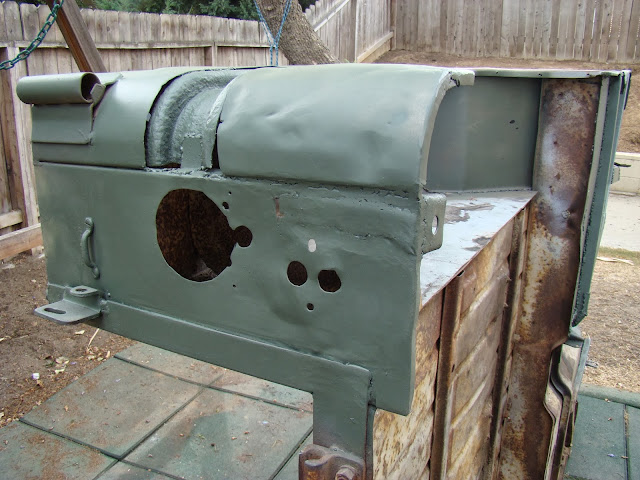The right rear quarter panel is easily the most rot infested area. The large section backed by the hat channel removed earlier was the bulk of it, but I started sanding away with the grinder and a 60 grit disc. The somewhat smooth surface gave way to pits of body filler and thin/rotting holes or cracks in the exterior sheet metal.
None of this really bothered me. It's not structural, but I do want the "cancer" out, so I'll address it as needed.Amazingly lumpy panel. Oh well. I won't spend much time/energy/effort/money getting the panel smooth. I use a bit of bondo, perhaps, just to make it look a little less like a golf ball.
Any attempt at welding this thin a metal will be problematic. I'll just burn through.
I got a metal backing plate roughly shaped to approximate the horizontal and vertical curves of these two splits. I overwhelmed them with booger welds that I'll grind down later.
This bracket is a body mount point, so it needs to be secure. I've already rust-treated the bracket itself, so now I've got to weld it to the sheet metal.
I drilled some holes for plug welds. Only that side of the bracket had busted loose from rust expansion.
A shot of the back side. Lots of surface rust, but the bracket itself is sturdy.Plug welds in place.
Then I cut a patch panel to fit, pretty much. Stitch welded it in place, along with some welds up the body seam that had separated. Note also the welds for the tailgate trim opening. Same thing as before: holes drilled for plug welds, clamped it down, welded to get good heat penetration.
Grinding it down. That revealed a small sliver that my patch panel didn't fully cover. I'm trying, as well, to grind in the body seam so that it will look somewhat stock when I'm done.
Fairly smooth now.
Primered. The lumps aren't as noticeable in the matte paint job. I'm definitely leaning more and more towards a fauxtina finish with a matte clearcoat.
Not too shabby. I'll patch that large hole near the fender lip tomorrow.
Here are a few hints of what's to come. This is the fuel filler flange from the driver's side of the donor tub. It's a keeper.
Some time with the air chisel and sawzall, and I got it off.
It looks lumpy and ugly at first, but I'm getting better at panel repair.
Not sure how many layers of paint here. I see red, yellow, and black, at minimum.




































































